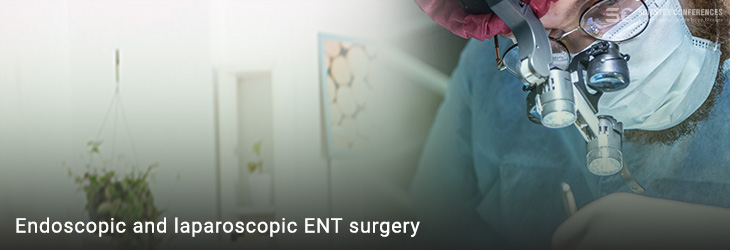Track: Endoscopic and laparoscopic ENT surgery

Session Overview:
This session will delve into the transformative role of endoscopic and laparoscopic techniques in the field of otolaryngology, emphasizing their applications, advancements, and benefits in diagnosing and treating various ENT conditions. As minimally invasive surgical methods, endoscopic and laparoscopic procedures have revolutionized traditional approaches, offering patients reduced morbidity, shorter recovery times, and improved postoperative outcomes. Key topics will include the principles and techniques of endoscopic surgery, with a focus on applications in nasal and sinus surgery, including functional endoscopic sinus surgery (FESS) and its impact on chronic rhinosinusitis treatment. The session will also explore advancements in laparoscopic techniques for managing head and neck conditions, such as thyroid and parathyroid disorders, highlighting how these methods facilitate better visualization and precision while minimizing incision size. The integration of advanced imaging technologies, such as high-definition endoscopes and robotic-assisted systems, will be discussed, showcasing how these innovations enhance surgical capabilities and outcomes. Furthermore, participants will learn about the importance of interdisciplinary collaboration in optimizing patient care and outcomes in minimally invasive procedures. By the end of the session, attendees will gain valuable insights into the current trends and future directions of endoscopic and laparoscopic surgery in otolaryngology, equipping them with knowledge to enhance their practice and improve patient care.
Recent Developments:
Recent advancements in endoscopic and laparoscopic ENT surgery have significantly enhanced the precision, safety, and efficacy of procedures within the field of otolaryngology. One major development is the integration of high-definition imaging technologies, such as high-definition endoscopes and advanced video systems. These innovations provide surgeons with superior visualization of anatomical structures, allowing for more accurate diagnoses and improved surgical outcomes, particularly in complex cases involving the nasal cavity and sinuses. The adoption of robotic-assisted surgical systems is another notable advancement, particularly in head and neck surgery. These systems allow for greater dexterity and control during delicate procedures, such as thyroidectomy and parathyroidectomy, enabling surgeons to perform intricate maneuvers with enhanced precision while minimizing tissue damage. Research into the long-term outcomes of these minimally invasive procedures has reinforced their effectiveness, with studies showing improved patient satisfaction and reduced complications compared to traditional open surgery. Furthermore, the incorporation of enhanced recovery after surgery (ERAS) protocols in endoscopic and laparoscopic ENT surgeries has optimized postoperative care, promoting faster recovery and shorter hospital stays. These developments reflect a broader trend toward personalized, patient-centred care in otolaryngology, emphasizing the importance of continued innovation in minimally invasive surgical techniques to improve patient outcomes and quality of life.
Sub Tracks:
Endoscopic Skull Base Reconstruction:
This sub-track will explore the techniques and approaches used in endoscopic skull base reconstruction, emphasizing advancements in surgical strategies and the importance of preserving surrounding anatomical structures.
Endoscopic Anatomy of the Skull Base and Parasellar Region:
Focus on the detailed anatomy relevant to endoscopic approaches to the skull base and parasellar region. This session will provide insights into the complex relationships between anatomical structures and their implications for surgical planning.
Functional Endoscopic Sinus Surgery (FESS):
Discuss the principles, techniques, and outcomes of FESS, focusing on its role in treating chronic rhinosinusitis and other sinonasal disorders. Highlight advancements in instrumentation and techniques that improve patient outcomes.
Otoscopy:
Examine the advancements in otoscopic techniques, including the use of digital otoscopes and enhanced imaging technologies that facilitate better visualization of the ear canal and tympanic membrane for accurate diagnosis and treatment.
Rhinoscopy:
Review techniques for anterior and posterior rhinoscopy, emphasizing their importance in diagnosing sinonasal conditions and guiding subsequent surgical interventions. Discuss innovations in instrumentation that enhance visualization.
Laryngoscopy:
Explore the applications and advancements in laryngoscopy, including video laryngoscopy and flexible laryngoscopy techniques for assessing laryngeal pathologies and guiding therapeutic interventions.
Endoscopic Sinus Surgery:
Investigate the various approaches and techniques in endoscopic sinus surgery beyond FESS, focusing on complex cases and the integration of advanced imaging modalities for optimal outcomes.
Anterior and Posterior Rhinoscopy:
Discuss the techniques, indications, and advancements in both anterior and posterior rhinoscopy, highlighting their roles in diagnosing and managing nasal and sinus conditions.
Esophagogastroduodenoscopy (EGD):
Examine the role of EGD in ENT, including its applications for evaluating oropharyngeal and laryngeal disorders, and discuss advancements in sedation and imaging technologies that enhance patient comfort and diagnostic accuracy.
Neuroendoscopy:
Explore the use of neuroendoscopy in treating various conditions affecting the cranial cavity and spinal cord, including minimally invasive techniques for tumor resection and cerebrospinal fluid management.
Digital Laparoscope:
Discuss the innovations in digital laparoscopy, including high-definition imaging and enhanced visualization techniques that improve the quality of laparoscopic procedures within the ENT field.
Telescopic Rod Lens System:
Review the advancements in telescopic rod lens systems, focusing on their applications in endoscopic and laparoscopic surgeries, including their impact on visualization and surgical precision.
Scientific Highlights
- Anatomical and Physiological Disorders of ENT
- Lung Disease Airway Issues
- ENT Infections and allergies
- New treatment Advances in Otolaryngology
- Ear & Nose plastic surgery
- Endoscopic and laparoscopic ENT surgery
- Craniofacial & Facial surgery
- Otology and Neurotology
- ENT Microsurgery
- COVID 19 and ENT
- Pediatric Otolaryngology
- Speech and Swallowing Disorders
- Head and Neck Surgery
- Airway Management & Surgery
- ENT Allergies & Immunotherapy
- Surgical Techniques in ENT
- Nasal Polyposis and Biologic Therapy
- Advances in Cochlear Implants
- Recent Advances in Otorhinolaryngology
- Vertigo and Balance Disorders


